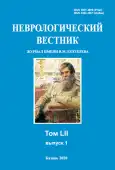Suicidal risk and characteristics of text written by patients with endogenous mental disorders
- Authors: Medvedeva T.I.1, Enikolopov S.N.1, Vorontsova O.Y.2
-
Affiliations:
- Mental Health Research Centre
- Mental Health Research Center
- Issue: Vol LII, No 1 (2020)
- Pages: 97-100
- Section: Brief communications
- URL: https://journals.rcsi.science/1027-4898/article/view/16505
- DOI: https://doi.org/10.17816/nb16505
- ID: 16505
Cite item
Full Text
Abstract
Aim. Identification of the relationship between suicidal risk and features of the text written by patients with endogenous mental diseases.
Methods. The study involved 58 people-patients with endogenous mental diseases who were being treated at the MHRC clinic. All patients were asked to write an essay on the topic “I, others, the world”. To analyze the semantic and syntactic structure of utterances, the method of relational-situational analysis and the method of frequency lexical analysis using the PLATIn analyzer were used. All patients completed the following methods: (1) SCL-90-R symptomatic questionnaire (Symptom Check List-90-Revised); (2) the Iowa game problem — the expectation-result model of Expectancy-valence is used, which introduces parameters for probabilistic modeling of decision-making: “attention to win-loss”, “learning-forgetting”, “impulsivity–determinism”; (3) The Barratt impulsivity scale [10]; (4) the five-factor personality questionnaire, the Bass–Perry questionnaire.
Results. The results of the Spearman correlation analysis showed statistically significant correlations between the severity of suicide risk (from the SCL-90 questionnaire) and the parameters of texts obtained using computer analysis, with the parameters of the Expectation-valence model of the Iowa game problem, the Barratt impulsivity scale, the Bass–Perry questionnaire, and emotionality in the five-factor personality questionnaire.
Conclusions. There were found the features of the text that are associated with increased suicide risk: increased use of past tense verbs in texts; higher productivity — increase in the number of sentences and words in the text while reducing the length of the words and decrease of the number of infinitives; the increase in the coefficient of Trager; reduced vocabulary positive rational assessment and mental activities; increase vocabulary of asthenic negative emotions. The analysis of the relationship between suicidal risk and personal characteristics revealed characteristics similar to those shown in the texts: a high level of hostility, increased emotionality, increased impulsivity and a pronounced momentary effect.
Keywords
Full Text
##article.viewOnOriginalSite##About the authors
Tatiana I. Medvedeva
Mental Health Research Centre
Author for correspondence.
Email: medvedeva.ti@gmail.com
ORCID iD: 0000-0002-6012-2152
SPIN-code: 6406-4368
ResearcherId: C-2974-2016
Researcher, Department of Clinical Psychology
Russian Federation, 115230, Moscow, Kashirskoye highway, 34Sergey N. Enikolopov
Mental Health Research Centre
Email: enikolopov@mail.ru
ORCID iD: 0000-0002-7899-424X
SPIN-code: 6911-9855
ResearcherId: C-2922-2016
PhD, Professor, Head of Clinical Psychology Department
Russian Federation, 115230, Moscow, Kashirskoye highway, 34Oksana Yu. Vorontsova
Mental Health Research Center
Email: okvorontsova@inbox.ru
ORCID iD: 0000-0001-5698-676X
SPIN-code: 3767-5067
Scopus Author ID: 56845286400
ResearcherId: O-4843-2018
Researcher, Department of Clinical Psychology
Russian Federation, 115230, Moscow, Kashirskoye highway, 34References
- Микиртумов Б.Е., Завитаев П.Ю. Аутизм: история вопроса и современный взгляд. СПб.: Н-Л. 2012; 143 с. [Mikirtumov B.E., Zavitaev P.Yu. Autizm: istoriya voprosa i sovremennyy vzglyad. (Autism: a background and a modern look.) Sankt-Peterburg: N-L. 2012; 143 p. (In Russ.)]
- Золотова Г.А., Онипенко Н.К., Сидорова М.Ю. Коммуникативная грамматика русского языка. М.: Ин-т рус. яз. РАН им. В.В. Виноградова. 2004; 540 с. [Zolotova G.A., Onipenko N.K., Sidorova M.Yu. Kommunikativnaya grammatika russkogo yazyka. (Communicative grammar of the Russian language.) M.: In-t rus. yaz. RAN im. V.V. Vinogradova. 2004; 540 p. (In Russ.)]
- Осипов Г.С. Приобретение знаний интеллектуальными системами. Основы теории и технологии. М.: Наука. Изд. фирма «Физ.-мат. лит.». 1997; 109 с. [Osipov G.S. Priobretenie znaniy intellektualʹnymi sistemami. Osnovy teorii i tekhnologii. (Knowledge acquisition by intelligent systems. Fundamentals of theory and technology.) M.: Nauka. Izd. firma “Fiz.-mat. lit.”. 1997; 109 p. (In Russ.)]
- Девяткин Д.А., Кузнецова Ю.М., Чудова Н.В. и др. Интеллектуальный анализ проявлений вербальной агрессивности в текстах сетевых сообществ. Искусственный интеллект и принятие решений. 2014; (2): 27. [Devyatkin D.A., Kuznetsova Yu.M., Chudova N.V. et al. Intelligent analysis of the manifestations of verbal aggressiveness in the texts of network communities. Iskusstvennyy intellekt i prinyatie resheniy. 2014; (2): 27. (In Russ.)]
- Derogatis L.R., Savitz K.L. The SCL-90-R and the Brief Symptom Inventory (BSI) in Primary Care In: M.E. Maruish (ed.) Handbook of psychological assessment in primary care settings. Mahwah, NJ: Lawrence Erlbaum Associates, Publishers. 2000: 297–334.
- Тарабрина Н.В. Практикум по психологии посттравматического стресса. СПб.: Питер. 2001; 272 с. [Tarabrina N.V. Praktikum po psikhologii posttravmaticheskogo stressa. (Workshop on the psychology of post-traumatic stress.) SPb.: Piter. 2001; 272 p. (In Russ.)]
- Медведева Т.И., Ениколопова Е.В., Ениколопов С.Н. Гипотеза соматических маркёров Дамасио и игровая задача (IGT): обзор. Психологич. исслед. 2013; 6 (32): 10. [Medvedeva T.I., Enikolopova E.V., Enikolopov S.N. Damasio’s Somatic Marker Hypothesis and Iowa Gambling Task (review). Psikhologicheskie issledovaniya. 2013; 6 (32): 10. (In Russ.)]
- Bechara A., Damasio H., Damasio A.R. Emotion, decision making and the orbitofrontal cortex. Cereb. Cortex. 2000; 10 (3): 295–307.
- Busemeyer J.R., Stout J.C. A contribution of cognitive decision models to clinical assessment: decomposing performance on the Bechara gambling task. Psychological assessment. 2002; 14 (3): 253–262.
- Ениколопов С.Н., Медведева Т.И. Апробация русскоязычной версии методики «шкала импульсивности Барратта» (BIS-11). Психология и право. 2015; 5 (3): 75–89. [Enikolopov S.N., Medvedeva T.I. Approbation of the Russian-language version of the [Barratt Impulsiveness Scale (BIS-11). Psikhologiya i pravo. 2015; 5 (3): 75–89. (In Russ.)] doi: 10.17759/psylaw.2015050307.
- Хромов А.Б. Пятифакторный опросник личности. Курган: Изд-во Курганского гос. ун-та. 2000; 23 с. [Khromov A.B. Pyatifaktornyy oprosnik lichnosti. (Five-factor personality questionnaire.) Kurgan: Izd-vo Kurganskogo gos. universiteta. 2000; 23 p. (In Russ.)]
- Ениколопов С.Н., Цибульский Н.П. Психометрический анализ русскоязычной версии опросника диагностики агрессии А. Басса и М. Перри. Психологич. ж. 2007; 28 (1): 115–124. [Enikolopov S.N., Tsibulʹskiy N.P. Psychometric analysis of Russian-language version of questionnaire for aggression diagnostics by A. Buss and M. Perry. Psikhologicheskiy zhurnal. 2007; 28 (1): 115–124. (In Russ.)]
- Самохвалов В.П. Психиатрия. Ростов-на-Дону: Феникс. 2002; 575 с. [Samokhvalov V.P. Psikhiatriya. (Psychiatry.) Rostov-on-Don: Feniks. 2002; 575 p. (In Russ.)]
Supplementary files






